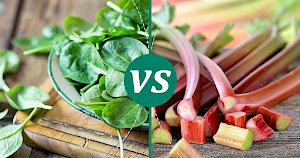Rhubarb vs Spinach: Nutrition, Calories & Protein Compared


Rhubarb vs Spinach
Nutrition Facts
Serving size:
change
5g10g15g20g30g40g50g60g80g100g120g140g160g180g200g220g250g300g350g400g450g500g600g700g800g900g1000g
1oz2oz3oz4oz5oz6oz7oz8oz10oz12oz15oz20oz25oz30oz35oz40oz50oz
Amount Per Serving:
Serving size:
change
5g10g15g20g30g40g50g60g80g100g120g140g160g180g200g220g250g300g350g400g450g500g600g700g800g900g1000g
1oz2oz3oz4oz5oz6oz7oz8oz10oz12oz15oz20oz25oz30oz35oz40oz50oz
Amount Per Serving:
Rhubarb vs Spinach 100g Compare
| per 100g | Rhubarb | Spinach |
|---|---|---|
| Calories | 21 | 23 |
| Carbohydrates | 4.54 g | 3.63 g |
| Fat | 0.2 g | 0.39 g |
| Dietary fiber | 1.8 g | 2.2 g |
| Protein | 0.9 g | 2.86 g |
| Calcium | 86 mg | 99 mg |
| Iron | 0.22 mg | 2.71 mg |
| Magnessium | 12 mg | 79 mg |
| Potassium | 288 mg | 558 mg |
| Sodium | 4 mg | 79 mg |
| Zink | 0.1 mg | 0.53 mg |
| Vitaminium A | 102 µg | 9377 µg |
| Vitaminium B1 (Thiamine) | 0.02 mg | 0.078 mg |
| Vitaminium B2 (riboflavin) | 0.03 mg | 0.189 mg |
| Vitaminium B3 (Niacin) | 0.3 mg | 0.724 mg |
| Vitaminium B5 | 0.085 mg | 0.065 mg |
| Vitaminium B6 | 0.024 mg | 0.195 mg |
| Vitaminium B9 (Folic acid) | 7 mg | 194 mg |
| Vitaminium C | 8 mg | 28.1 mg |
| Vitaminium E | 0.27 mg | 2.03 mg |
| Vitaminium K | 29.3 µg | 482.9 µg |
| Beta karoten | 61 mg | 5626 mg |
Discovering the Nutritional Treasures of Rhubarb and Spinach
When it comes to enriching our diet with vegetables, rhubarb and spinach often emerge as popular choices. Each boasts a unique set of nutrients and health benefits that cater to diverse dietary needs. But how do these two powerhouses stack up against each other in terms of nutritional value? Let's delve into an intriguing comparison that sheds light on the distinct qualities of rhubarb and spinach, guiding you towards making informed decisions for your health and well-being.
A Tale of Two Vegetables: Rhubarb and Spinach
Rhubarb, with its tart flavor and bright red stalks, is often associated with pies and desserts. Interestingly, it is a vegetable, not a fruit. On the other hand, spinach, a leafy green known for its mild taste, is a staple in salads, smoothies, and a variety of cuisines worldwide. Both vegetables are celebrated for their low calorie content and a plethora of vitamins and minerals, but they serve up their nutritional benefits in different ways.
Calories and Macronutrients: A Closer Look
When comparing the caloric content, rhubarb and spinach are nearly neck and neck, with rhubarb containing approximately 21 calories per 100 grams and spinach slightly higher at 23 calories. This marginal difference highlights both as excellent choices for those monitoring their calorie intake.
- Carbohydrates: Rhubarb leads with 4.54 grams, while spinach follows closely with 3.63 grams per 100 grams.
- Fiber: Spinach edges out with 2.2 grams, contributing to digestive health, against rhubarb's 1.8 grams.
- Protein: Spinach is a clear winner in this category, offering 2.86 grams compared to rhubarb's 0.9 grams, making it a better option for those seeking to increase their protein intake.
Vitamins and Minerals: The Essentials
Both vegetables are powerhouses of vitamins and minerals, each with its unique offerings:
- Iron and Magnesium: Spinach is significantly richer in iron and magnesium, crucial for energy production and muscle health.
- Vitamin A: Spinach also takes the lead in vitamin A content, essential for vision and immune function, boasting 9377 IU compared to rhubarb's 102 IU.
- Vitamin K: With a staggering 482.9 micrograms, spinach far surpasses rhubarb in vitamin K, which is vital for blood clotting and bone health.
- Calcium: Both vegetables contribute to bone health, with rhubarb containing 86 mg and spinach slightly higher at 99 mg of calcium per 100 grams.
Which One to Choose?
Ultimately, the choice between rhubarb and spinach boils down to personal preference and nutritional needs. Rhubarb, with its distinct tartness, can add a unique flavor to desserts and baked goods, while offering a decent dose of vitamins and minerals. Spinach, on the other hand, is a versatile vegetable that can be easily incorporated into a variety of dishes, providing a superior boost in protein, iron, and several key vitamins.
Incorporating both rhubarb and spinach into your diet can diversify your nutrient intake and add exciting flavors to your meals. Whether you lean towards the tangy zest of rhubarb or the mild, earthy taste of spinach, both vegetables are nutritious choices that can contribute to a balanced and healthy diet.
Rhubarb 100g
21kcalCalories source
- 77% CARBS.
- 15% PROTEIN
- 8% FAT
Spinach 100g
23kcalCalories source
- 49% CARBS
- 39% PROTEIN
- 12% FAT
Compares of rhubarb
- Rhubarb vs Beetroot
- Rhubarb vs Bok Choy
- Rhubarb vs Carrot
- Rhubarb vs Cauliflower
- Rhubarb vs Kale
- Rhubarb vs Leek
- see all compares of rhubarb
Marcin Piotrowicz
calories-info.com creator
Healthy diet and healthy lifestyle promoter
Add comment